
Euphorbia esula, commonly known as green spurge or leafy spurge, is a species of spurge native to central and southern Europe, and eastward through most of Asia north of the Himalaya to Korea and eastern Siberia.

Myrrhis odorata, with common names cicely, sweet cicely, myrrh, garden myrrh, and sweet chervil, is a herbaceous perennial plant belonging to the celery family Apiaceae. It is the only species in the genus Myrrhis.

Eryngium alpinum, the alpine sea holly, alpine eryngo or queen of the Alps, is a herbaceous perennial plant in the family Apiaceae.

Laserpitium latifolium, common name broad-leaved sermountain, is an herbaceous perennial plant in the genus Laserpitium of the family Apiaceae.

Eriogonum flavum is a species of wild buckwheat.
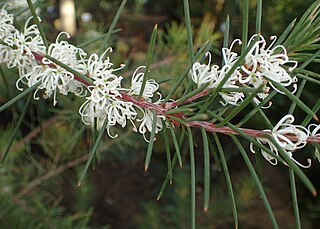
Hakea sericea, commonly known as bushy needlewood or silky hakea, is a large shrub with a profusion of mainly white flowers from July for several months. It is endemic to eastern Australia. It has become an environmental weed in some countries.

Allium cratericola is a species of wild onion known by the common name Cascade onion. It is endemic to California, where is an uncommon member of the flora in several of the state's mountain ranges, including the northern and southern California Coast Ranges, the western Transverse Ranges, Klamath Mountains, and the Sierra Nevada foothills. Its range covers much of the state, from Riverside County to Siskiyou County.

Allium yosemitense is a California species of wild onion known by the common name Yosemite onion. Most of the known populations are situated within the boundaries of Yosemite National Park.
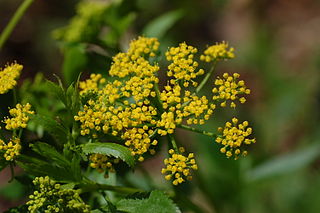
Zizia aurea is a flowering perennial forb of the carrot family (Apiaceae). Golden alexanders is native to eastern Canada and the United States, from the eastern Great Plains to the Atlantic Coast. Named for Johann Baptist Ziz, a German botanist.

Peucedanum verticillare, common name giant hog fennel or milk parsley, is a herbaceous plant in the genus Peucedanum of the family Apiaceae.
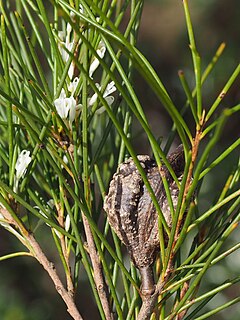
Hakea ochroptera is a species of flowering plant in the family Proteaceae and is endemic to a restricted area of New South Wales. It is a shrub with long, needle-shaped leaves and an abundance of cream-white flowers in spring.

Nothoscordum bivalve is a species of flowering plant in the Amaryllidaceae known by the common names crowpoison and false garlic. It is native to the southern United States from Arizona to Virginia, as well as Mexico, Peru, Uruguay, northeastern Argentina and central Chile.
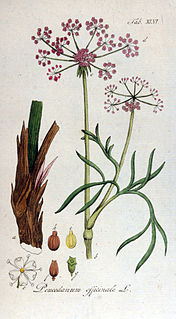
Peucedanum officinale is a herbaceous perennial plant in the family Apiaceae found mainly in Central Europe and Southern Europe. It is also native to the UK, where it has the common names hog's fennel and sulphurweed, but it is a rare plant there, occurring only in certain localities in the counties of Essex and Kent. It was formerly also found near the town of Shoreham-by-Sea in the county of West Sussex, but has long been extinct there.
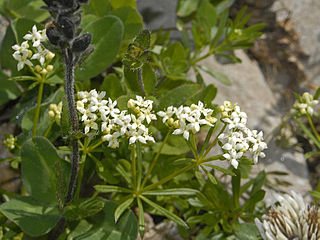
Galium anisophyllon, common name bedstraw or gaillet, is a flowering perennial plant in the family Rubiaceae.
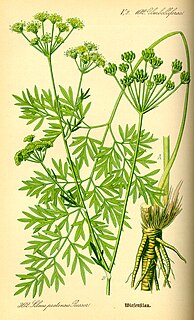
Silaum silaus, commonly known as pepper-saxifrage, is a perennial plant in the family Apiaceae (Umbelliferae) found across south-eastern, Central and Western Europe, including the British Isles. It grows in damp grasslands on neutral soils.

Astrantia major, the great masterwort, is a species of flowering plant in the family Apiaceae, native to central and eastern Europe. Growing to 90 cm (35 in) tall by 45 cm (18 in) broad, it is an herbaceous perennial, much used in gardens.

Tordylium maximum, known as hartwort, is an annual or biennial flowering plant in the carrot family (Apiaceae).
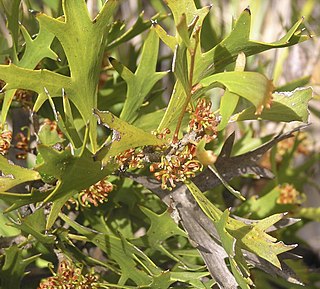
Hakea ceratophylla, commonly known as the horned leaf hakea, is a shrub in the family) Proteaceae and is endemic to the southwest of Western Australia. It is a stiff shrub with variably-shaped leaves that are sometimes lobed and flowers with white or rusty-coloured hairs.

Seseli libanotis, also known by the common names moon carrot, mountain stone-parsley, or säfferot, is a species of herb in the genus Seseli of the carrot family, Apiaceae. It is native to Eurasia, throughout which it is widespread.
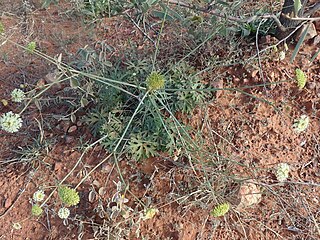
Trachymene ochracea is a herb in the family Araliaceae. It is native to Australia and found in New South Wales and Queensland.

























